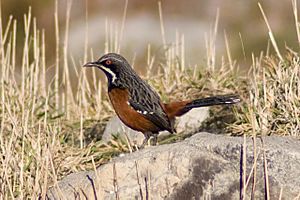Cape rockjumper facts for kids
Quick facts for kids Cape rockjumper |
|
|---|---|
 |
|
| Conservation status | |
| Scientific classification | |
| Genus: |
Chaetops
|
| Species: |
frenatus
|
The Cape rockjumper (Chaetops frenatus) is a special bird found only in the mountains of southernmost South Africa. It is also sometimes called the rufous rockjumper. This medium-sized bird loves to eat insects. It lives in a unique type of mountain plant area called Fynbos.
Contents
About the Cape Rockjumper
How Scientists Classify Them
For a long time, scientists weren't sure where the Cape rockjumper fit in the bird family tree. First, they thought it was a type of thrush. Later, they moved it to the babbler family. But in the 1990s, new genetic studies showed that rockjumpers are so unique, they needed their very own family! This family is called Chaetopidae.
There are two main types of rockjumpers: the Cape rockjumper and the Drakensberg rockjumper. Even though they are very similar, most bird experts and guides today consider them two different species.
Where They Live
Cape rockjumpers live only in a special mountain habitat called Alpine Fynbos. This area stretches from Cape Town to Port Elizabeth in South Africa. These birds are very picky about where they live. They need cool mountain temperatures. They prefer steep slopes with lots of big rocks. These rocks are perfect for perching and watching for danger.
What They Eat
Cape rockjumpers spend most of their time on rocky slopes. They are always on the lookout for food! Their main diet is insects. This includes caterpillars, moths, grasshoppers, beetles, and flies. Sometimes, they also eat other small creatures. These can be lizards, geckos, amphibians, scorpions, worms, and spiders.
These birds don't fly very often. Their wings are quite small. Instead, they love to run and jump among the rocks and grasses. They might take long glides down a hill or across a valley.
Family Life and Nests
Cape rockjumper families usually have a breeding pair. They also have one or two helpers. These helpers are often young birds from the year before. They help protect their family's territory. They also give alarm calls if danger is near. Most importantly, they help feed the baby birds in the nest.
Both the male and female birds help build the nest. They also take turns sitting on the eggs to keep them warm. Nests are built on the ground. They are usually hidden under rocky overhangs. This protects them from bad weather. The nests are lined with soft fur from red rock hare or fluffy protea seed pods.
A female rockjumper might try to build several nests in one season. This happens if earlier nests don't work out. They might even build a new nest after a successful one!
Staying Safe: Predators
Because their nests are on the ground, baby rockjumpers face many dangers. Snakes are a big threat. The Boomslang snake is a common predator. Other animals that might try to eat eggs or chicks include the Cape grey mongoose and the honey badger. Some other snakes like the Cape cobra or puff adder might also be a danger.
Interestingly, nests in areas that had a fire a few years ago (3-5 years) are more successful. This might be because there are fewer predators around after a fire.
Why Hot Weather is a Problem
Cape rockjumpers are used to a very specific range of temperatures. They are "alpine habitat specialists." This means they are very sensitive to heat. In warmer parts of their home, their numbers are going down. Scientists found that these birds don't handle heat well. Baby rockjumpers are even more sensitive than adult birds. They might not be able to drink enough water to stay cool when it's hot.
When it's hot, it's also harder for the birds to find food. And at higher temperatures, they tend to have smaller babies. This shows how important it is to keep their mountain homes cool.
How They Look
The Cape rockjumper is about 23 to 25 centimeters long. It has a long black tail and strong legs.
- Males: Have a dark grey and black head. They have a thin white line above their eye (like an eyebrow). They also have a wide white "moustache" stripe. Their back and wings are dark grey. Their belly and rump are a reddish-brown color.
- Females and Young Birds: Look a bit different. Their head, back, and wings are a paler grey. Their head patterns are not as bright. Their rump is orange, and their belly is a dull yellow-brown color.
- Eyes: Adult birds have bright red eyes. Young birds have black eyes until they grow up.
- Call: Their call can be one to four sharp whistles. It can also be a series of trilling sounds.
The Drakensberg rockjumper looks similar but lives in a different area. The male Drakensberg rockjumper has orange underparts. Its female and young birds are paler than the Cape rockjumper.



